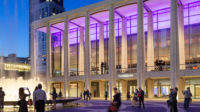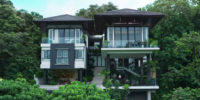Hadid Makes Her New York Stage Debut

Hadid Makes Her New York Stage Debut
With the blue-screen technique, a patch of green becomes a rushing city subway, the girl on the grass sent hurtling through it.
Photo: © Pino Pipitone

Hadid Makes Her New York Stage Debut
Blue-screen technology creates a composite image, transforming a soft, verdant costume into strident urban signage, and revealing a figure otherwise hidden from view.
Photo: © Stephanie Berger

Hadid Makes Her New York Stage Debut
Hadid’s concept for the Metapolis set began with a plane incised with a grid of wavy lines, shown here in a computer rendering. The structural components of the set were lifted out of this matrix, like origami.
Photo: © Zaha Hadid

Hadid Makes Her New York Stage Debut
The origami framework—also likened to bellows—established the set as a group of space-forming vectors, not stationary objects.
Photo: © Zaha Hadid

Hadid Makes Her New York Stage Debut
Hadid originally wanted to cover the stage with a web of bridgelike forms, as seen in this model. Flam and selected only three of these for the set.
Photo: © Zaha Hadid

Hadid Makes Her New York Stage Debut
Dancers in gray-and-black costumes echo the metallic stage structures, suggesting the confluence of the human and industrial in the urban fabric.
Photo: © Pino Pipitone

Hadid Makes Her New York Stage Debut
According to Flamand, “People create small architectures as they choreograph their lives.” Here, Hadid’s illuminated backdrop of splayed arcs suggests the forces of technology rampant in the environment.
Photo: © Stephanie Berger

Hadid Makes Her New York Stage Debut
The Vitruvian Man, once the center of the universe, loses his bearings. In one startling scene, his virtual image is suspended above him, upside down.
Photo: © Stephanie Berger



Post a comment to this article
Report Abusive Comment